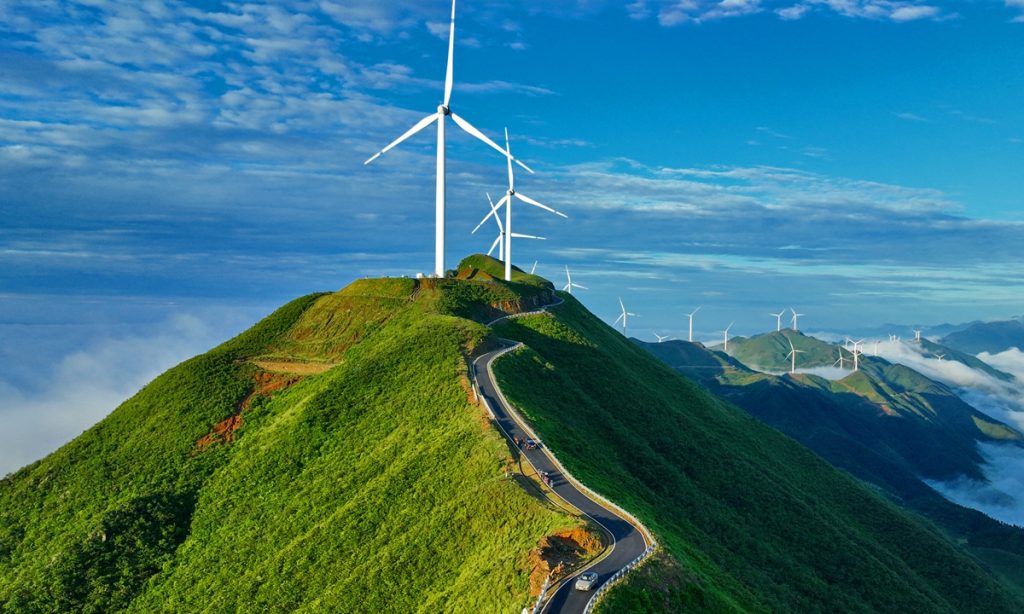Analysts refuted accusations of “overcapacity” recently spread by some Western countries, noting that such increases in new energy installations demonstrated China’s efforts to meet its commitment to achieve carbon neutrality by 2060.
They also pointed out that, from a global perspective, greater installed capacity is required in energy generation from clean sources (wind, photovoltaic, hydroelectric and others) to comply with the green transition around the world.
According to statistics released on Monday by China’s National Energy Administration (NEA), photovoltaic power installations totaled about 660 GW in the first quarter, a year-on-year increase of 55 percent. Wind energy installations grew by 21.5 percent annually, reaching about 460 GW.
Total installed power generation capacity stood at around 2,990 GW at the end of March, a year-on-year increase of 14.5 percent.
As China advances its green transformation, the share of renewable energy installations continues to rise, exceeding 50 percent of total power generation capacity by December 2023, according to the NEA.
Analysts said that although power generated from new energy sources has increased significantly, there is still huge potential for the deployment of green power generation, aimed primarily at meeting domestic demand for the green transition.
In the first quarter, China’s total electricity use rose to 2.34 trillion kilowatt-hours, a year-on-year increase of 9.8 percent, according to NEA statistics.

Wind turbines are seen in the mountains of Shangyou county, Ganzhou in East China’s Jiangxi Province on June 11, 2023. As of the end of April, the installed capacity of wind power rose 12.2 percent year-on-year to approximately 380 million kilowatts, official data showed. Photo: VCG
The increase in installed electricity capacity reflects China’s growing energy demand linked to its economic recovery, Hu Qimu, deputy secretary-general of the 50th Forum on the Integration of Digital and Real Economies, told the Global Times on Monday. “As China’s economy recovers, energy demand will continue to increase.”
Chinese demand for photovoltaic products remains strong. There is still room for further growth after years of rapid development, especially in the building-integrated photovoltaic systems market, Feng Chao, CEO of a Zhengzhou-based energy company, told the Global Times on Monday.

default
Photovoltaic units distributed on the roof of a company in Xuzhou, east China’s Jiangsu Province, April 22, 2024. As of the end of March, China’s installed solar power capacity reached around 660 GW, an increase of 55 percent year-on-year. year. -year, as official data shows. Photo: VCG
In response to the Western brouhaha over “overcapacity,” Hu noted that Western countries continue to develop their coal-fired power generation capacities while setting up trade barriers against Chinese green products such as photovoltaic panels, although they need Chinese products to improve your green transitions.
To combat climate change, resources need to be fully mobilized around the world. Globally, green capacity is not excessive, but in reality it is extremely scarce. The problem now is not “excess capacity” but “excess anxiety,” Xie Feng, China’s ambassador to the United States, said Friday at the opening ceremony of the Harvard Kennedy School’s China 2024 Conference. , according to the official website of the Chinese Embassy in the United States.
The World Economic Forum (WEF) said in February that, along with demand-side interventions such as energy efficiency, a rapid and responsible scale-up of renewable energy is critical to the transition, aligning with the ambitious goal set in the COP28 to triple the energy installed in the world. renewable energy generation capacity to at least 11,000 gigawatts by 2030.
According to an International Energy Agency report in January, the amount of renewable energy capacity added around the world grew by 50 percent in 2023, reaching almost 510 gigawatts.
That’s a gap of 10,490 gigawatts from the WEF’s 2030 forecast.
“Calling for a stronger climate response on the one hand but erecting green trade barriers on the other would only raise the costs for one’s own low-carbon transition, and also slow down the global development of clean energy,” Xie stressed.
In a fireside chat with Founding Dean of Harvard Kennedy School Prof. Graham Allison on Friday, Xie also noted that the US is asking China to run barefooted while one wears high-tech track shoes in a race by slapping sanctions on Chinese companies according to its own domestic laws and forcing other countries to ban exports of certain devices and technologies to China.
“Even when barefooted, some top Chinese players, such as producers of electric vehicles, lithium-ion batteries and PV products, have managed to take the lead. The US then accuses them of causing ‘overcapacity’ and posing a threat to other contestants, demanding they quit the race. This is not fair,” Xie noted.